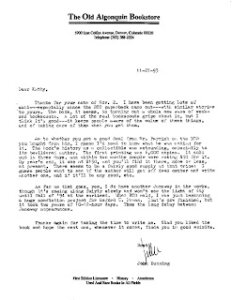The following is a reprint from the Bookscout’s Corner on www.oldalgonquin.com with permission from John Dunning.
- Desirability: Judging value of a book starts with the subject matter. If the book does not have anything of value to say, then no one will want it. For example many people still have in their attics old novels from the late 19th and early 20th century that may have been popular fiction at the time, but no one cares about anymore. Age alone does not make a book valuable.
- Rarity. Books are subject to the same laws of supply and demand as any other goods. If there is only one copy of a book but no one is interested in purchasing it, then it will have no value. However if two or more people want that book, then the price will increase to whatever the market will bear.
- Edition. Usually only the first or limited editions are collectible. However, a later edition that contains important new information may be preferred in some cases. You need to be able to properly determine which edition you have by learning to read the title and copyright pages. It is also important to have the dust jacket, with its original price intact, to properly identify the edition. Books listed below can help.
- Condition. A most important determinant of value. Both book and dust jacket are considered and need to be in the best possible condition. This includes no ink or crayon marks, previous owner’s names, bookplates, or embossers. A book worth $500 in fine condition may be worth next to nothing if it is frayed, soiled, or broken. Also the book must be complete in all its parts including dust jacket if there was one, pictures, endpapers and title page, etc.
- Signatures. An inscription or signature by the author can increase the value of a book, especially in cases where the author is known to have signed very few books. Some author’s signatures are plentiful or inconsquential and will do little to raise the price of a book.
- Association copies. The term “association” is applied to any book which is verifiably associated with another famous person. For example, William Faulkner might have inscribed a book to F. Scott Fitgerald, or a book might contain the bookplate of a famous collector.
- Binding. The original binding is preferable to any rebinding unless the original binding was so worn as to defy restoration. A rebound book may be valuable as a work of art, and on some early books the bindings were done after the book was sold in parts, so there may be different bindings of a first edition by different bookbinders.
Here are examples of some good reference books for collectors and book dealers.
- “A Pocket Guide to the Identification of First Editions” – Be sure to get their most recent edition. They also have the booklet “Points of Issue”, and other related booklets.
- “A Collectors’ Guide to First Editions” by Allan and Patricia Ahearn has been replaced by “Collected Books 2002: The Guide to Values“. It has a wealth of information for collectors as well as the approximate prices for thousands of collectible books.
- A great magazine for collectors is Firsts Magazine which is published nine times a year. It has very informative articles on collectible books and authors, information on collecting, binding, condition standards, and links to many major book dealers. Click here for their website Firsts.
For books you can’t find here, other sites include www.abaa.org, www.biblio.com, www.bookfinder.com, www.abebooks.com, and www.alibris.com. We don’t recommend ebay unless you have researched the details of what you want before bidding. Many people sell on ebay (as well as other sites) that don’t know how to properly identify edition, condition, etc.

